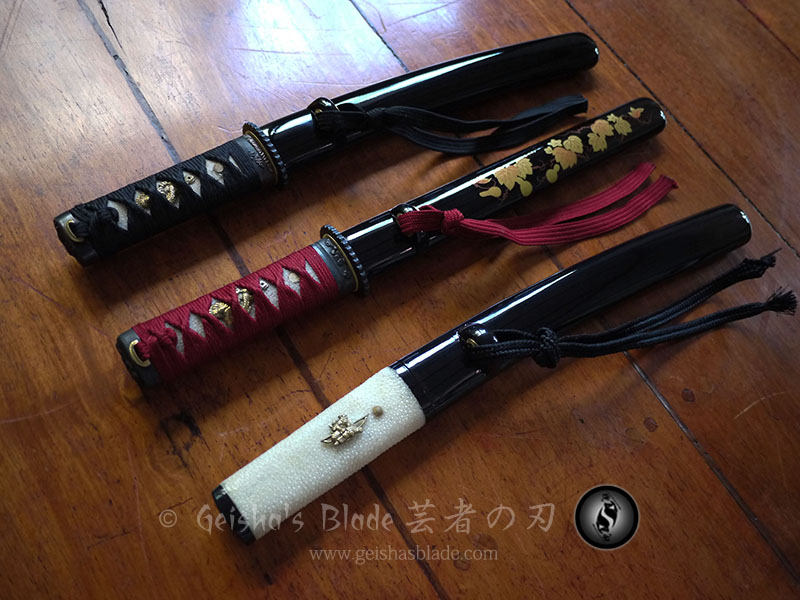New Geisha’s Blade Tanto

Here’s something else to look forward to at Geisha’s Blade, restock of our tanto and a new model.
The Unokubi Zukuri Tanto and Momiji Tanto are not new. We started selling them last 2010 but haven’t restocked them for quite a while. But because of popular demand, we decided to bring them back in again.
The Unokubi Zukuri Tanto, as the name implies, has an unokubi zukuri blade shape. The term unokubi translates to “cormorant’s neck”. It refers to the tapering of a portion of the back of the blade giving it a false edge, while retaining the shape of the kissaki. The blade has a small groove called “soe-hi” that runs along the shinogi or ridge line of the blade. It also has a “koshi-hi” which is a short groove with a rounded top. The koshi-hi usually suggests the sword of Fudo Myoo. It’s meaning is the same as the “Ken” horimono (engraving) which is the symbol of power of Buddha (or any Buddha). It’s the most simple symbol of prayers. A koshi-hi with a longer soe-hi suggests a Buddha with his polearm.
From top to bottom: Unokubi Zukuri Tanto, Momiji Tanto, Osoraku Zukuri Tanto
Our old version of the Unokubi Zukuri Tanto had a blade length of 9.5 inches and tsuka length of 5.5 inches. With our new stocks, the length of the tsuka is still the same, but the length of the blade is now 11 inches. We decided to make the blade longer so it will be more proportion to the length of the tsuka. We also changed the menuki design from a namazu (catfish) to the more symbolic dragon menuki. The fuchi-kashira depicts a “Shishi” or Lion Dog and bamboo leaves. The price of the Unokubi Zukuri Tanto is still the same as our previous stocks which is PHP 4,500.
“Momiji” means maple leaf in Japanese which is the design of the saya of our Momiji Tanto. The red tsukaito compliments the maple leaves which turns red during Autumn. Our Momiji Tanto has a shinogi zukuri blade shape (common blade shape of Japanese swords) with no sori (curvature). Just like our Unokubi Zukuri Tanto, we also made the blade longer to 11 inches and retaining the same tsuka length of 5.5 inches. We also changed the menuki design from a namazu (catfish) to the more symbolic dragon menuki. The fuchi-kashira depicts sakura or cherry blossoms. The design of the saya features maple leaves and a gourd which is made to look like “maki-e”. The price of the Momiji Tanto is still the same as our previous stocks which is PHP 4,500.
Previous stocks of our Unokubi Zukuri and Momiji tanto used to have a wire brushed hamon. With our new stocks, we decided not to have the wire brushed hamon as we’re planning to acid etch a hamon. It’s still fake a hamon, but looks better than wire brushed. We’ll be posting photos when we’re done.
The newest addition to our tanto line is the Osoraku Zukuri Tanto. Like our Unokubi Zukuri Tanto, the name also refers to the shape of the blade. The kissaki (tip) is bigger than half of the blade’s length, which is considered an O-kissaki (large kissaki). This is a rare blade shape was developed by Shimada Sukemune of the Shimada school of swordsmithing during the late Muromachi period of Japan. The tsuka of our Osoraku Zukuri Tanto has a full wrap real samegawa (ray skin). This technique is called “maru-kise” (round wrapped). The fuchi-kashira is made of real buffalo horn. The menuki, made of brass, features Bushi wearing yoroi engaged in hand to hand combat. This tanto is considered an “aikuchi” since it doesn’t have a tsuba. Aikuchi is a type of tanto koshirae where the fuchi is flushed with the koiguchi (mouth of the saya). The nagasa (blade length) of the Osoraku Zukuri Tanto is 11 inches while the tsuka length is 5 inches. The habaki features a “neko-gaki” or cat scratch pattern (also called “falling rain”) which is usually seen on nihonto with high quality koshirae (sword fittings). The price of the Osoraku Zukuri Tanto is PHP 12,000.
Our original design for this tanto was for it to have a through-hardened (TH) 1050 carbon steel blade only like our Unokubi Zukuri and Momiji Tanto. But the overall design of this tanto is so beautiful, a TH 1050 carbon steel blade won’t give the design justice. So we decided to make it with a differentially-hardened (DH) 1050 carbon steel with a natural hamon instead, in which we had dificulties taking photos of it, but can be easily seen in person. It was also photographed in poor lighting that’s why the hamon was not visible in some of the photos. We decided not to make the blade with 1060, 1095, or T10 as we believe a DH 1050 carbon steel would be enough for a tanto.
We are currently working on our inventory, inspecting each swords, and taking new photos to be used as stocks photos. So it may take us a while to update the stocks on our website. Hopefully these will be available for purchase by next week. Just keep checking our Facebook page for updates!











